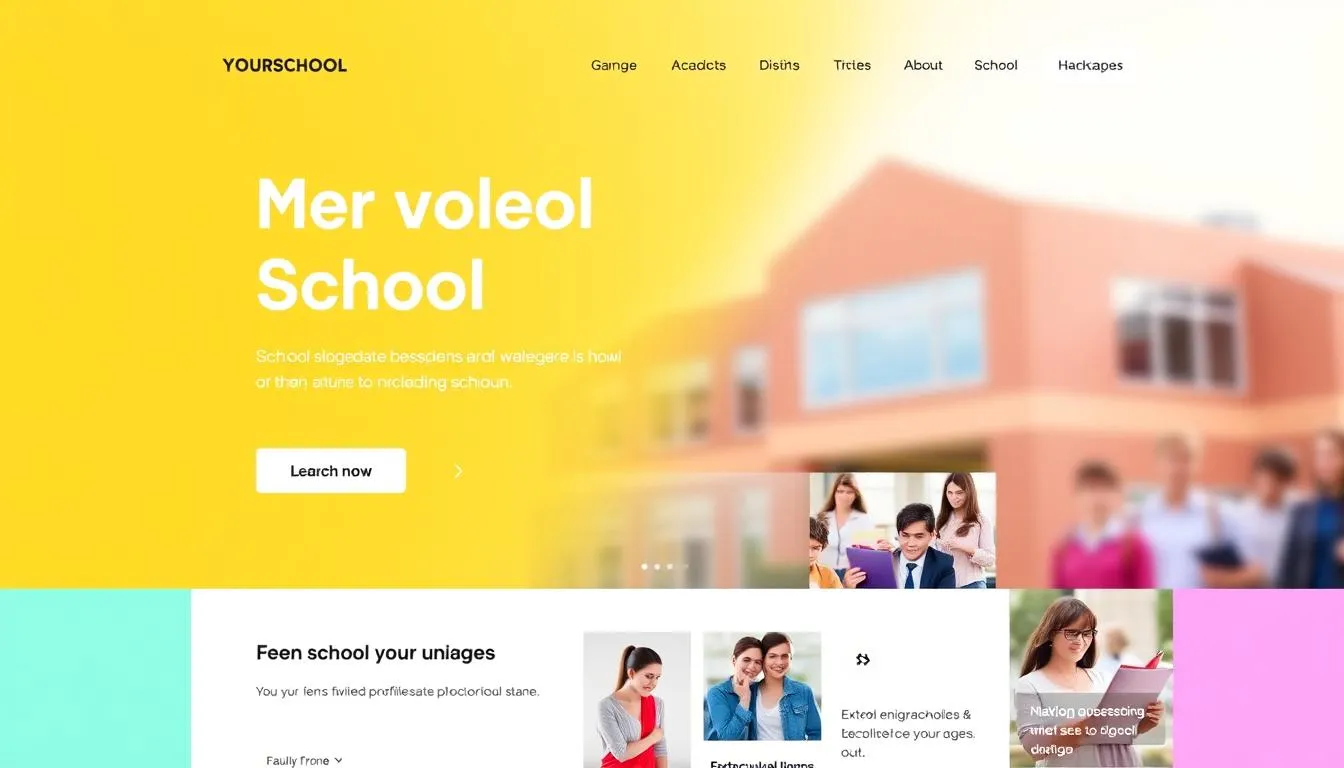Last Updated on: June 19, 2025
In today’s digital age, a professional school website is crucial for establishing a strong online presence. It not only enhances the school’s reputation but also provides a platform to communicate with parents, students, and the community.
A well-designed school website design can make a significant difference in how your school is perceived online. It serves as a central hub for information, resources, and engagement, making it an essential tool for modern education.
Key Takeaways
- A professional school website enhances the school’s reputation.
- Effective communication with parents, students, and the community is facilitated through a well-designed website.
- A school website serves as a central hub for information and resources.
- It is an essential tool for modern education.
- A well-designed website can significantly improve online presence.
The Importance of a Well-Designed School Website
A well-designed school website is crucial for making a positive first impression on prospective parents and students. In the digital age, a school’s website often serves as the initial point of contact, setting the tone for the institution’s image and reputation.
First Impressions Matter for Educational Institutions
A professional educational website design can significantly influence how parents and potential students perceive the school. A modern, user-friendly website conveys a sense of innovation and quality, making the school more attractive to prospective families. It’s essential to create a website that is both visually appealing and easy to navigate.
How a Professional Website Supports Educational Goals
Web design for schools goes beyond aesthetics; it plays a critical role in supporting educational objectives. A well-structured website facilitates communication between teachers, parents, and students, enhancing the overall educational experience. It provides a platform for sharing information, resources, and achievements, thereby fostering a sense of community within the school.
By investing in a professional web design for schools, educational institutions can create an online presence that not only reflects their values but also supports their educational mission.
Key Features Every School Website Should Have
When it comes to creating a school website, several key features are essential for success. A school website serves as a central hub for information, communication, and community engagement.
Essential Navigation and Content Elements
A well-structured school website should have clear navigation and relevant content. This includes menus that are easy to use, news updates, event calendars, and contact information. The website should also provide a search function to help users quickly find the information they need.
Mobile Responsiveness for Parents on the Go
With the majority of users accessing websites through mobile devices, a responsive design is crucial. A mobile-responsive website adapts to different screen sizes, ensuring that parents and students can access important information on-the-go.
Accessibility Compliance for Educational Websites
Ensuring accessibility compliance is vital to cater to all users, including those with disabilities. This involves following guidelines such as the Web Content Accessibility Guidelines (WCAG 2.1) to make the website usable for everyone.
Where Can I Find Web Design Services for a School Website?
Schools looking for professional web design have various avenues to explore, from specialized agencies to DIY platforms. The key is to find a service that understands the unique needs of educational institutions and can deliver a website that effectively serves students, parents, and staff.
Specialized Education Website Design Agencies
Specialized education website design agencies offer tailored solutions for schools. These agencies have experience in creating websites that meet the specific needs of educational institutions, including compliance with relevant regulations. They provide comprehensive services, from design to development and maintenance, ensuring a professional online presence for your school.
Freelance Web Designers with Educational Experience
Freelance web designers with experience in educational projects can offer personalized services to schools. They often bring a high level of creativity and flexibility to the design process, allowing for a website that truly represents the school’s unique character and values.
Website Builder Platforms with School Templates
For schools on a tighter budget or with limited technical expertise, website builder platforms with school templates offer a convenient and cost-effective solution. These platforms provide pre-designed templates and user-friendly tools, making it easier to create and manage a school website without extensive web development knowledge.
Evaluating Web Design Companies for Your School
Evaluating potential web design companies is essential to ensure your school’s website meets your needs. A well-designed website is crucial for any educational institution, serving as a digital face for the school and a resource for students, parents, and staff.
Portfolio Review: Examining Past School Website Projects
When evaluating web design companies, reviewing their portfolio is a critical step. Look for companies that have experience in designing school websites, as they will better understand your needs. Examine their past projects to assess their design style, functionality, and ability to meet educational requirements.
Questions to Ask Potential School Web Designers
Asking the right questions can help you make an informed decision when selecting a web design company. Some key questions to ask include: What is your design process? What content management systems do you use? What kind of support and maintenance services do you offer? By asking these questions, you can better understand their capabilities and ensure they can meet your school’s needs.
By carefully evaluating web design companies and asking the right questions, you can find a partner that will help you create an effective and engaging school website.
Understanding the School Website Design Process
Understanding the intricacies of the school website design process is crucial for educational institutions aiming to establish a strong online presence. This process is multifaceted, involving several stages that ensure the final product is both functional and effective in communicating the school’s mission and values.
Discovery and Planning Phase
The initial stage of the school website design process is the discovery and planning phase. During this critical phase, the web design company works closely with the school to understand its needs, goals, and target audience. This involves gathering information about the school’s existing brand, identifying the key messages to be conveyed, and determining the required features and functionalities of the website.
Design and Development Timeline
Following the discovery phase, the design and development stage commences. This stage involves creating the visual design and user experience (UX) of the website, followed by the actual development using appropriate technologies and content management systems (CMS). A typical design and development timeline can vary depending on the complexity of the project, but it usually takes several weeks to a few months to complete.
Testing and Launch Procedures
Before the website is launched, thorough testing is conducted to ensure that it is functional, secure, and meets the required standards. This includes testing for usability, compatibility with different browsers and devices, and compliance with accessibility standards. Once testing is complete, the website is launched, and the school is trained on how to manage and update the content.
“A well-designed website is not just about aesthetics; it’s about creating an online environment that supports the educational mission of the school.”
— Expert in Educational Technology
By understanding and following this structured design process, schools can ensure that their website effectively serves their community and supports their educational goals.
Budgeting for Your School’s Website Project
Effective budgeting for a school website involves understanding the typical cost ranges for educational website design. This knowledge enables schools to plan and allocate resources efficiently, ensuring that their online presence is both effective and sustainable.
Typical Cost Ranges for School Website Design
The cost of designing a school website can vary widely, depending on factors such as the complexity of the design, the number of pages, and the features required. Here are some key factors that influence the cost:
- Design complexity: Custom designs with unique features cost more than template-based designs.
- Number of pages: Larger websites with more pages require more content creation and development time.
- Features and functionality: Integrating advanced features like online payment systems or student portals increases costs.
On average, the cost for a school website can range from $3,000 to $15,000 or more, depending on the scope of the project.
Maximizing Value Within Educational Budgets
To maximize the value of your school’s website within the allocated budget, consider the following strategies:
- Prioritize your needs: Focus on essential features and functionalities that meet your educational goals.
- Consider scalable solutions: Choose a website design that can grow with your school’s needs.
- Ensure a good return on investment: Invest in features that enhance user engagement and provide valuable resources for your community.
By understanding the costs and prioritizing your needs, you can create a valuable online presence for your school.
Content Management Systems for School Websites
A Content Management System (CMS) is the backbone of a dynamic school website, enabling easy updates and management. It allows school administrators and staff to maintain the website without needing extensive technical knowledge.
WordPress for Educational Institutions
WordPress is a popular choice for educational institutions due to its flexibility and extensive plugin library. It offers a user-friendly interface that makes it easy for staff to manage content, update news, and share events. With thousands of themes available, schools can choose a design that aligns with their brand and preferences.
Specialized School CMS Platforms
Besides WordPress, there are specialized CMS platforms designed specifically for educational needs. These platforms offer tailored features such as curriculum management, student information systems, and parent-teacher communication tools. They provide a comprehensive solution for managing both the website and internal educational processes.
Ease of Updates for School Staff
One of the key benefits of a CMS is the ease of updates it offers to school staff. With a user-friendly dashboard, staff members can quickly add new content, modify existing pages, and publish announcements without relying on IT support. This autonomy ensures that the website remains fresh and relevant, reflecting the latest news and developments within the school.
Compliance and Security Considerations
Ensuring compliance and security on your school’s website is crucial in today’s digital landscape. Schools handle sensitive information, making it imperative to adhere to regulations and protect data.
FERPA and COPPA Requirements for School Websites
The Family Educational Rights and Privacy Act (FERPA) and the Children’s Online Privacy Protection Act (COPPA) are critical regulations that schools must comply with. FERPA protects the privacy of student education records, while COPPA regulates the collection of personal information from children under 13. Ensuring your website complies with these regulations is vital.
Data Protection and Student Privacy Measures
Implementing robust data protection measures is essential for safeguarding student privacy. This includes secure data storage solutions, controlled access to sensitive information, and transparent privacy policies. Schools must also educate staff on best practices for handling student data.
By prioritizing compliance and security, schools can maintain trust with parents and students while protecting sensitive information.
Essential School Website Content Planning
Content planning plays a vital role in creating an effective school website. A well-structured content plan ensures that the website is informative, engaging, and meets the needs of its various stakeholders.
Organizing Information for Different Stakeholders
Organizing content for different stakeholders, such as parents, students, and staff, is crucial. This can be achieved by creating separate sections or pages tailored to each group’s needs. For instance, parents might need information on school policies, events, and parent-teacher conferences, while students might be looking for resources on homework, extracurricular activities, and school news.
Creating Engaging Content for Your School Community
Creating engaging content is vital for building a sense of community. This can include news articles, event announcements, and stories about student achievements. Regular updates keep the website fresh and encourage repeat visits. According to a recent study, “schools that regularly update their website see increased engagement from parents and students”
“The key to a successful school website is regularly updated content that resonates with the school community.”
John Smith, Educational Technology Expert
Showcasing School Achievements and Programs
Showcasing school achievements and programs not only enhances the school’s reputation but also attracts prospective families. This can be done through success stories, achievement highlights, and detailed descriptions of educational programs.
By focusing on these aspects, schools can create a website that is both informative and engaging, serving the needs of their community effectively.
School Website Design Best Practices
School web design best practices play a vital role in creating an engaging and informative online platform. A well-designed website not only enhances the user experience but also supports the educational goals of the institution.
Branding Consistency Across Digital Platforms
Maintaining branding consistency across all digital platforms is crucial for reinforcing the school’s identity. This includes using consistent logos, color schemes, and typography across the website and social media channels. By doing so, schools can create a cohesive and recognizable brand image.
User Experience Considerations for Parents and Students
When designing a school website, it’s essential to prioritize user experience. This involves creating intuitive navigation, clear information architecture, and ensuring that the site is accessible on various devices. Key considerations include:
- Easy access to important information such as calendars, news, and contact details
- Clear and concise content that caters to different stakeholders
- Mobile responsiveness to accommodate parents and students on-the-go
Incorporating Social Media Integration
Social media integration is vital for enhancing connectivity and encouraging the sharing of school news and events. By linking the website to social media platforms, schools can foster a stronger online community and improve engagement. Some effective ways to integrate social media include:
- Displaying social media feeds directly on the website
- Sharing content across platforms to maximize reach
Conclusion: Elevating Your School’s Online Presence
A well-designed professional school website is crucial for enhancing your school’s online presence. By understanding the importance of a professional website and selecting the right web design services, you can create a site that effectively communicates your school’s mission and values.
Following best practices in school website design ensures that your site is user-friendly, accessible, and engaging for parents, students, and staff. This, in turn, supports your educational goals and enhances your school’s reputation.
By investing in a high-quality website, you can establish a strong online presence that benefits your entire school community. A school online presence that is informative, engaging, and easy to navigate is essential for building trust and fostering a sense of community.
FAQ
What is the importance of having a professional website for schools?
A professional website is crucial for schools to establish a strong online presence, enhance their reputation, and communicate with parents, students, and the community.
What are the key features every school website should have?
Essential features include clear menus, news updates, event calendars, contact information, mobile responsiveness, and accessibility compliance.
Where can I find web design services for my school's website?
You can consider specialized education website design agencies, freelance web designers with educational experience, or website builder platforms with school templates.
How do I evaluate web design companies for my school's website?
Review their portfolio, assess their experience in designing school websites, and ask questions about their design process, content management systems, and support services.
What is the typical cost range for school website design?
Costs vary depending on the complexity of the design, number of pages, and features required, but understanding typical cost ranges can help you plan your budget.
What Content Management System (CMS) is suitable for school websites?
Popular options include WordPress and specialized school CMS platforms, which offer flexibility, ease of updates, and tailored features for educational needs.
How can I ensure my school's website is compliant with regulations like FERPA and COPPA?
Ensure data protection and student privacy measures are in place, including secure data storage, controlled access to sensitive information, and transparent privacy policies.
What are the best practices for school website design?
Best practices include branding consistency, user experience considerations, and incorporating social media integration to create an effective online presence.
How can I plan essential content for my school's website?
Organize information for different stakeholders, create engaging content, and showcase school achievements and programs to build a sense of community and enhance your school’s reputation.
What is the school website design process?
The process typically involves discovery and planning, design and development, testing, and launch procedures to ensure a functional, secure, and relevant website.




